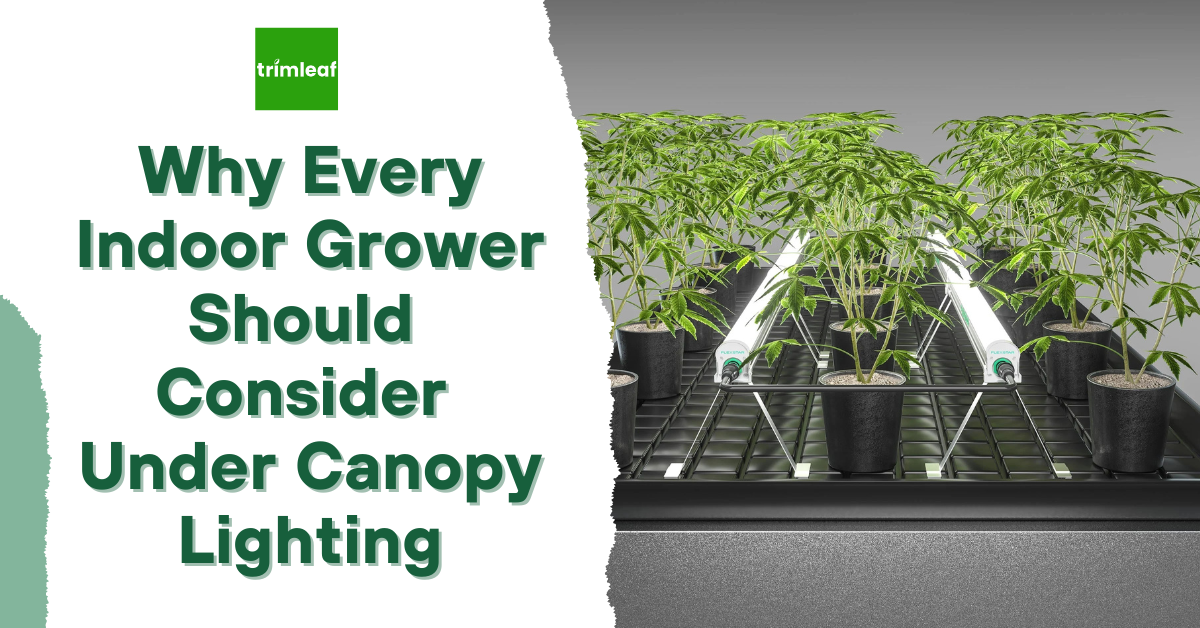
Achieving full-spectrum illumination across the entire plant canopy is a challenge in indoor cultivation. Traditional overhead LED grow lights often leave the lower canopy in shade, limiting photosynthesis and reducing bud quality and overall yield. Under canopy lighting (UCL) is a rapidly emerging category of LED technology that solves this by delivering targeted light to the middle and lower regions.
Under canopy lighting help growers optimize photosynthesis throughout the entire canopy, improve bud density, and maximize overall harvest weight. Both scientific principles and real-world results support this advanced lighting strategy, quickly becoming a game-changer for those seeking to push the boundaries of indoor cultivation efficiency.
Table of Contents
- Why Your Plants Need Under Canopy Lighting
- Benefits of Under Canopy Lighting for Cannabis Growers
- Potential Drawbacks of Under Canopy Lighting
- How Under Canopy Lighting Works
- Choosing the Right Fixtures
- Placement and Mounting
- Integration With Your Lighting System
- Environmental Considerations
- Is Under Canopy Lighting Worth It?
- Conclusion
- Frequently Asked Question About Under Canopy Lightning
Why Your Plants Need Under Canopy Lighting

Under canopy lights only supplement—not replace—your primary overhead LEDs or HPS lights. They should be used in combination with top lighting to create a truly uniform light profile from top to bottom.
When plants are grown on benches or vertical racks, upper leaves and buds block sunlight or LED light from reaching the lower canopy. This shadowing stunts lower bud development, weakens plant structure, and often requires labor-intensive pruning to prevent disease.
Installing LED grow lights under the canopy ensures that all parts of your plant receive enough light for healthy, balanced growth.
Benefits of Under Canopy Lighting for Cannabis Growers
Here are data-driven reasons why under canopy lighting can be a breakthrough:
Increase Yield
Studies consistently show that under-canopy lights can boost cannabis yields by 20–30% compared to overhead lights alone. Some commercial growers even report yield increases of up to 60% in dense, multi-layer setups.
Better Light Distribution
Traditional top lights leave the lower canopy shaded. Under canopy LEDs deliver balanced, uniform light from the ground up, increasing photosynthesis in lower leaves by 15% according to horticultural studies.
Boost Chlorophyll Production
Optimal light at all canopy levels means healthier plants. Experiments have shown a 10% increase in chlorophyll content when under-canopy lights are used, directly improving photosynthetic efficiency.
Improve Flower Quality
With more light reaching all flower sites, growers see more “A” and “B” grade buds even on lower branches. One study found that under-canopy lighting increased flower count by 18% and improved density and color.
Shorten Growth Cycle
Continuous, targeted lighting can speed up plant growth. Under-canopy lighting can cut 7–10 days off the time from seed to harvest, helping you get more cycles per year.
Reduce Disease and Mold
Shaded, humid pockets in the lower canopy can foster mold and bacteria. Under-canopy lights lower humidity under the plant, reducing gray mold risk by up to 25% according to applied microbiology research.
Potential Drawbacks of Under Canopy Lighting
❌ Upfront costs can be significant, but ROI is usually earned within 1–2 harvests.
❌ Poorly positioned lights may increase substrate temperature, requiring additional airflow or cooling.
❌ More fixtures mean more electrical planning and potential for crowding in tight spaces.
❌ In sparse canopies or very small grows, the benefits may not justify the extra equipment.
How Under Canopy Lighting Works

Choosing the Right Fixtures
Full-spectrum under canopy lightning are high-quality or provide customizable spectrums, supporting all plant stages from veg to flower. Look for lights with adjustable output, heat dissipation, and daisy-chaining options.
Placement and Mounting
Position the plant under canopy lights approximately 8–12 inches above the substrate or pot base. This height prevents direct heat stress on roots while delivering enough PPFD (photosynthetic photon flux density) to the lower leaves and buds.
Install the bars parallel to benches or grow trays to maximize even coverage under the plant canopy.
Integration With Your Lighting System
Start with the under canopy lights at 40–50% output when you first introduce them (usually at the beginning of the flowering stage). Gradually increase intensity over 2–3 weeks to allow plants to adapt without stress.
Environmental Considerations
Adding lights beneath the canopy can slightly raise temperatures at the root zone and alter humidity under dense foliage. It’s important to monitor microclimate changes and adjust fans or HVAC as needed for optimal VPD (vapor pressure deficit).
Position fixtures so they do not obstruct air movement. Good airflow remains critical to prevent localized heat build-up or mold.
Is Under Canopy Lighting Worth It?

Yes, for many indoor and commercial growers, under canopy lighting is worth it, especially if you’re struggling with poor lower bud development or maximizing yields in high-density or vertical setups.
The upfront cost of under canopy LEDs can be higher than grow lights, but the return on investment is typically seen within just one or two harvests. For growers running large-scale cannabis operations, multi-level racks, or greenhouses where lower light penetration is a bottleneck, the value is even more noticeable.
However, under canopy lighting isn’t always necessary. If you’re running a small grow with few plants, using aggressive defoliation techniques, or maintaining very open canopies, the marginal gains may not justify the extra cost or complexity. In these cases, optimizing your top lighting and plant training methods could be more cost-effective.
Conclusion
Under canopy lighting is revolutionizing indoor growing by bringing powerful, efficient light directly to every level of your plants.
The result? Higher yields, healthier flowers, less disease, and more efficient use of your growing space. Whether you’re cultivating cannabis, leafy greens, or other high-density crops, adding under canopy lighting could be the best investment you make for your next harvest.
Ready to see the difference for yourself? Explore under canopy lighting and unlock your grow’s full potential.
Frequently Asked Question About Under Canopy Lightning
- ◄What is under canopy lighting and how is it different from traditional grow lighting?
- Under canopy lighting refers to LED fixtures placed beneath the plant canopy to illuminate lower leaves and buds—areas that traditional overhead lights often miss. It doesn’t replace top lighting but complements it for full-spectrum coverage from top to bottom.
- ◄Will under canopy lighting really increase my yield?
- Yes. Studies and commercial growers report yield increases of 20–30%, with some seeing up to 60% gains in dense, multi-tier setups. More light means more photosynthesis—and more buds.
- ◄When should I introduce under canopy lighting during the grow cycle?
- Start during the early flowering stage. Begin with lights at 40–50% intensity and increase gradually over 2–3 weeks to avoid stressing your plants.
- ◄Can under canopy lighting help reduce mold or disease?
- Absolutely. By illuminating and drying out the lower canopy, under canopy lights can reduce gray mold risk by up to 25% and discourage other pathogens that thrive in dark, humid zones.
- ◄How far should under canopy lights be from the plant base?
- Position them about 8–12 inches above the substrate or floor. This prevents heat stress at the root zone while still delivering effective light to lower growth areas.
- ◄Are under canopy lights worth it for small home grows?
- Not always. If your grow is small, open, or heavily defoliated, the benefits may be minimal compared to the cost. For larger or denser grows, though, the ROI is usually seen within 1–2 harvests.
- ◄What spectrum should I look for in under canopy lights?
- Look for full-spectrum LEDs or lights with customizable output to support both vegetative and flowering stages. Quality lights also feature good heat dissipation and daisy-chaining options.
- ◄Will these lights affect the temperature or humidity in my grow space?
- Yes, slightly. Under canopy lights can raise temperatures near the root zone and may affect humidity under dense foliage. Monitor your VPD and airflow closely, and adjust HVAC or fans as needed.
- ◄Can I use under canopy lighting in vertical rack systems?
- Definitely. UCL is particularly effective in multi-tier vertical farms, where lower levels receive very little light from above. They help ensure even bud quality across all layers.
- ◄Do I need to change anything else in my setup when using UCL?
- Just a few tweaks: maintain good airflow to prevent heat buildup, adjust humidity if needed, and gradually increase light intensity to allow your plants to adapt. Proper integration is key to maximizing results.




